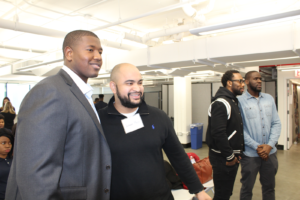Your Kid Just Said He’s Not Going to College, Now What?

Your kid says he’s not going to college, what do you do?
It’s worse because Penny perfect parent just mentioned that Susie super student just got into Stanford–add a layer of envy to your concern.
You know the data, on every measure of economic well-being–from employment, to earnings, to job satisfaction–young college graduates are outperforming their peers with less education. Millennials with only a high school diploma earn 62% of what the typical college graduate earns.
College remains a near universal aspiration in this country, even in the face of steeply rising costs. But a 2014 Northeastern study found that students born in the mid-1990s or later are overwhelmingly in favor of going to college, but they’re not too keen on taking out loans to pay for it. Two third of respondents said they are worried they won’t be able to afford college and opposed to acquiring student debt. Nearly one-third of the teenagers said college costs are “not worth it” and that the “costs will outweigh the benefits.”
Jr. may have spotted the stubbornly high youth unemployment rate, heard about rising prices and detected a declining return on investment from second tier degrees. Or, he was bored in school and just didn’t feel like going.
What’s a parent to do when a kid that was supposed to go to the U goes off the rails?
It probably won’t work trying to make Jr. do what he’s decided against. He’ll just waste your money and his time. It’s better to wait until he’s motivated. The worst case scenario is that he goes to the U, screws off and leaves without a degree and a lot of debt.
Start by asking Jr. how he thinks he’s going to make a living and if he’s got longer term aspirations. Listen before advising. Find out what’s going on, is it boredom, an alternative plan, money, or a girl?
If and when it makes sense, run these 10 higher education (HigherEd) options by Jr.
- Good work experience. It’s really important, whether Jr. goes to college now or later, to get good work experience. It will help him figure out what he wants to do, and not do. Anything you can do to help identify and secure an internship or job that would include valuable work experience is a big plus.More than 60 percent of teens told Northeastern researchers that they wanted to learn more about entrepreneurship. Tell Jr. to check out Steve Blank’s course on Udemy.
- Free HigherEd. Most states allow dual enrollment options where students can take classes at or from a community college and earn both high school and college credit. Encourage Jr. to take advantage of as many as possible. Transferability varies by state, but dual enrollment makes it possible to earn one or two years worth of college credit while in high school.There are a growing number of career and technical training programs available to high school students that combine work experience, job certificates, and college credit opportunities. For example, GPS Education Partners in Wisconsin combines manufacturing work experience, high school completion, and college credit opportunities.
- Delayed HigherEd. If Jr. delays college, he won’t be alone. The traditional 18-22 year-old student is now the minority in higher education. Late degree earners and adults going back to school are the new majority. It’s better to wait than waste. A gap year of work and travel is a great option.
- Flexible HigherEd. With lots of public and private onsite and online options, it’s easier than ever to work and learn. Online HigherEd options include Kaplan, Strayer, and Phoenix.
- Stackable HigherEd. Gaining a career certificate in high school can lead to good paying jobs and scholarships for HigherEd. We saw great examples of this at RAMTEC in northern Ohio where a couple young men could finish degrees with $50k in the bank rather than $50k in debt.Rather than thinking about HigherEd as a one time event after high school, in a growing number of fields a sequence of credentials (often called stackable) earned over a career.
- Sponsored HigherEd. Starbucks College Achievement Plan pays for an online degree from ASU.College for America, a program of Southern New Hampshire University, is aimed at low wage working adults. It costs $5K per year but Pell grants may cover that and the motivated students can finish the program quickly (see feature).
- Military sponsored HigherEd. Military service can make HigherEd free or affordable. The Armed Forces tuition assistance provides up to $4,500 annually for tuition and fees; the Post-9/11 GI Bill pays 40-100% of tuition and fees at a in-state public college or university, or up to $17,500 at a private or foreign school. ROTC programs allow students to prepare for military service and pay for college at the same time. Alternatively, Jr. can still serve his country and receive $5,500 per year of service (up to three years) with AmeriCorps.
- HigherEd alternatives. Massively open online courses (MOOC) exploded in 2012. They continue to surface and support global talent but most providers pivoted to job training in 2014. Coursera offers free online college courses and Specializations, a sequence of career-focused online courses. They are enthusiastic about Learning Hubs, local support groups formed around Specializations. Udacity offers free computer science courses and certificates called Nanodegrees. Informal online learning markets like Skillsoft and Udemy are a great place to pick up job skills (or learn the guitar).
- Code schools. There are a growing number of careers where demonstrated skills are more important than a degree. Codes schools are a new route to great jobs. Options include General Assembly, Bloc, and Flatiron. Most offer a 12 week program for about $12,000. Not cheap, but most completers get good job offers.
- DIY. With all these new ways to learn, there are a growing number of ways to assemble and share an alternative to a transcript. Building a portfolio with evidence of quality work and references is a new requirement. Try Degreed.com, for a start.
Degrees still matters but there are more rapid affordable degree pathways than ever. And there are a growing number of valuable degree alternatives. In most fields, work experience is as important as a degree. Link interest and information to help Jr. form a productive HigherEd pathway.
For more, see:








0 Comments
Leave a Comment
Your email address will not be published. All fields are required.